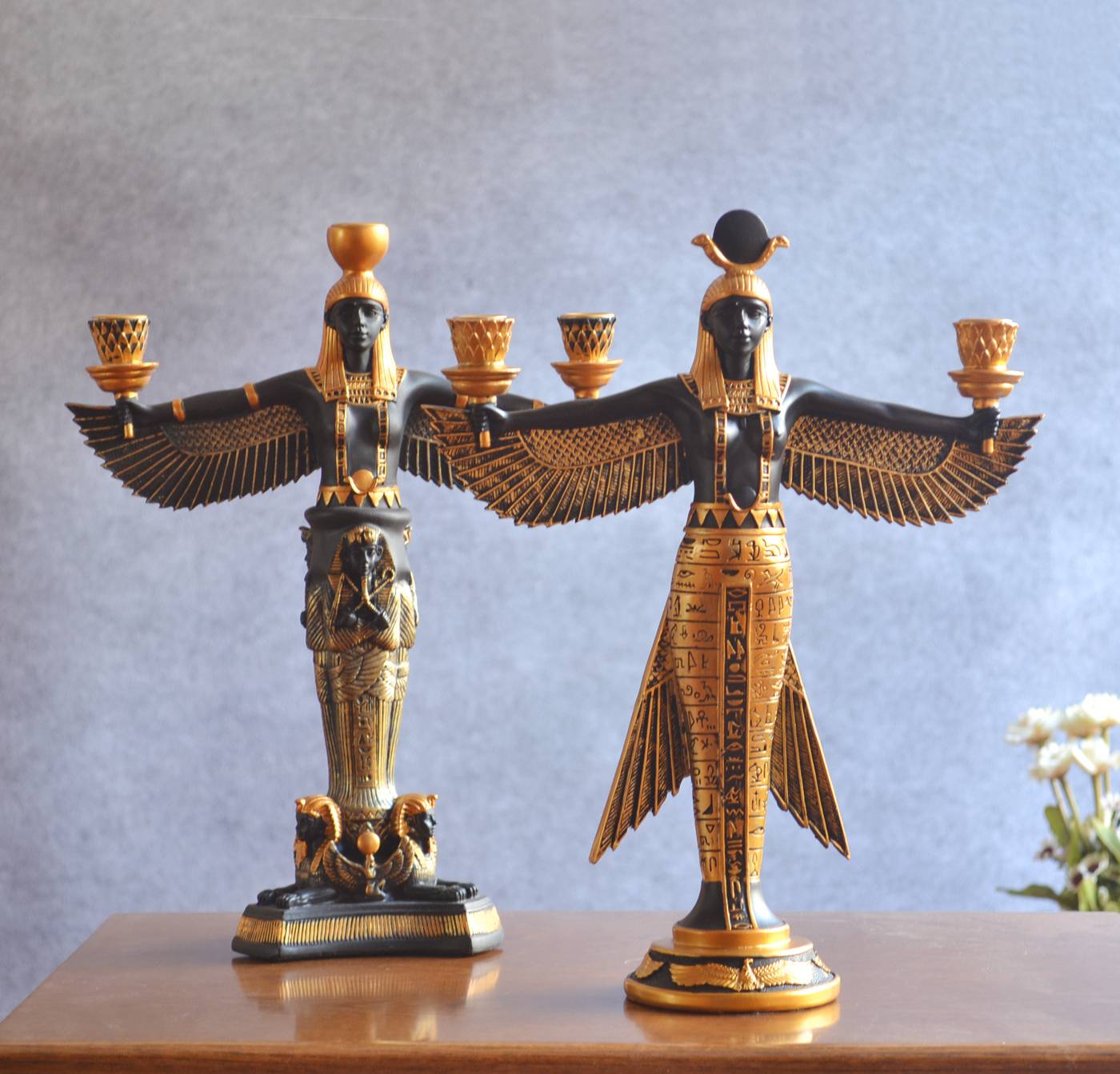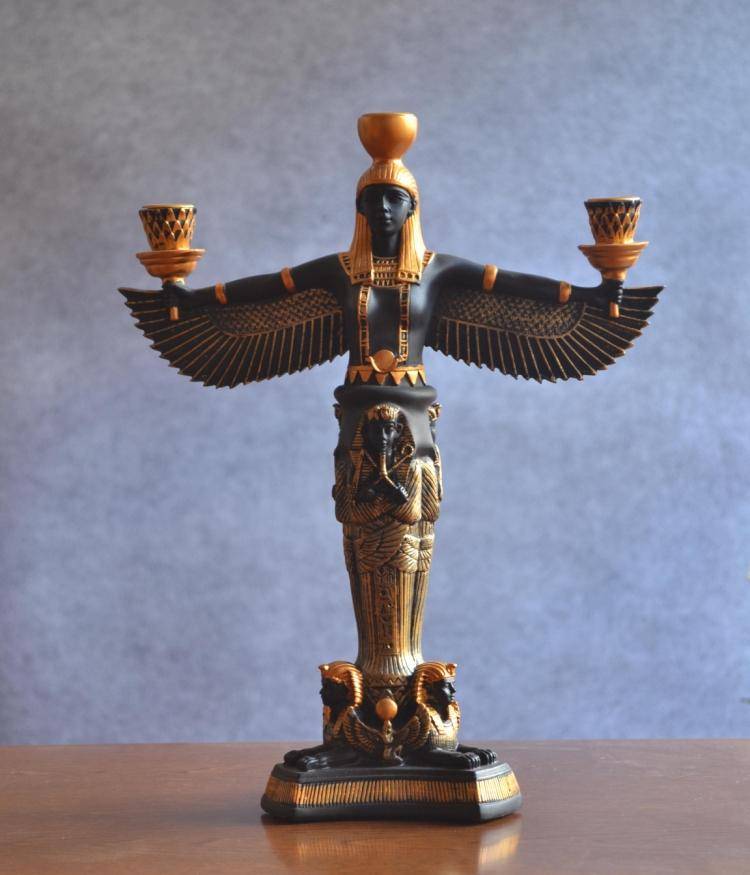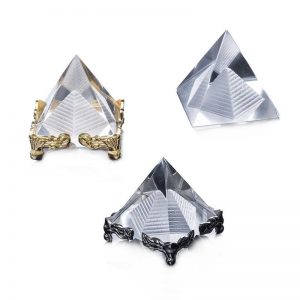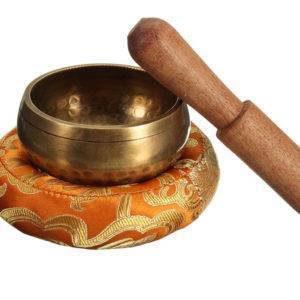Description
The goddess ISIS wings candle holders / Figurine
Width: 28cm height: 35cm(13.7795 inches) base: 12.5cm (4.92126 inches)
Ma’at: The Way of Life (Greek: Mayet)
Ma’at represents the concept and the Goddess associated with truth, order, justice and ‘that which is right’. Kemetic society hinged completely on the furtherance of Ma’at, Who was considered to be the true first emanation of the Self-Created One, and depicted as a teenage woman with wings or alternatively a teenage woman with Her symbol, a single white ostrich feather, bound to her head.
Ma’at in antiquity was the patroness of judges and all court officials; the phrase ‘Priest of Ma’at’ in inscriptions can generally be understood as meaning a judge or magistrate. Ma’at’s feather symbol is weighed against the ka (heart-soul) of the deceased in the Hall of Judgement after death, a place also known as the Hall of Ma’ati, Double Truth (double in Kemetic implying something more serious or intense as a single something, much like we use the terms ‘extra’ or ‘advanced’ in English)
Ma’at is more often given as an offering, rather than a Goddess to Whom offerings are made. The ‘Offering of Ma’at’ is a ritual dating from very ancient times, where Ma’at as a principle (ma’at) is given to the Gods, Who in turn return it to the universe as order. As an idea that each devotee strives to achieve in his/her life, the doing of Ma’at can be considered a perpetual offering, and all create, sentient beings, are considered to be Her offspring and responsibility.
When Ma’at is invoked as a Goddess rather than a concept, Her place as the first daughter of the Created (here, The God Ra) is emphasized:
Aset: Mistress of Magic (Heka) (Greek Name: Isis)
‘The Throne’, Aset is the power that makes kings; a Goddess appearing in texts beginning in Dynasty 4 as wife and sister to Wesir and daughter of Nut and Geb. In earliest times, Aet is depicted as Weret-hekau, the Mistress of Magic Who learns Ra’s true name and thus the secrets of the universe.
In the cult of Wesir, Aset is attributed to having prepared Him for burial and conceiving a son during the short period of resurrection in which Wesir was brought back to life before descending into the underworld and becoming king. (in early Kemetic texts, Wesir’s death is attributed to drowning; the dismemberment myth well-known from the histories of Plutarch does not appear until a millennia later and may not have even been Kemetic in origin). In later periods and in particular after the New Kingdom, Aset was syncretized with a number of Goddesses, even some outside of Kemet, such as the Greek Hera. During this period, Aset’s importance as mother of Heru-sa-Aset (a Name intimately connected with kingship and therefore within Aset’s purview as kingmaker) became paramount, in strong ways suggestive of (and very likely influencing) the later Christian cult of the Blessed Virgin Mary. The Romans declared all Goddesses to be forms of Aset, dubbing her ‘Isis, Goddess of Ten Thousand Names’, though Kemetic mythology does not exhibit this specific archetype, and as Isis, She was worshipped without interruption in nearly every country in the western world until well into the Middle Ages.
Aset seems to be very accepting of any sincere offering, although She tends to prefer luxury items or items She knows her devotees have put more than an average effort into obtaining. She adores jewelry, especially silver and lapis lazuli and enjoys refined and exquisite foods and drinks.
Hethert: She of Gold (Greek name: Hathor)
Another Name known from predynastic times, Hethert represents the feminine principle, as reflected in several of Her symbols: the cow, the mirror, and the ritual rattle or sistrum. Hethert is the patroness of women, and professions given to Her priesthood include dancers, singers, actors, and acrobats; even up to Greek times the arts were under Hethert’s dominion. Hethert’s temples, especially that at Ta-Netjer (Arabic Dendera) were centers for both healing (with a hospital/sanatorium on-site) and midwifery. Priests in the temple of Ta-Netjer conducted oracles with Hethert in trance rituals held in crypts underneath the sanctuary, and any person could sleep on the temple roof and hope for a dream, which could be interpreted the next morning by the priests. Even today, one can see graffiti and gameboards left behind by those pilgrims, carved into the stones of Ta-Netjer’s roof. Hethert’s association with both cows and the sistrum probably results from Her assimilation of the Predynastic Netjer Bat; “sistrum capitals” atop the pillars throughout Kemetic temples show Hethert’s full face with cow’s ears atop a “naos”-style sistrum. Hethert was closely associated with Heru-Behdety at Edfu, perhaps influencing the fact that She was a patroness of Kemet’s queens (as Heru is to the king, so Hethert is to the queen). Some queens are referred to by Hethert’s titles of “Mistress of Heaven” and “Lady of Gold.” Nefertari’s spectacular temple at Abu Simbel in Nubia depicts the Great Royal Wife as Hethert in many places; and her husband Ramses II is depicted in its sanctuary, suckling from the udder of Hethert as a divine cow.
Hethert is the patroness of women, and professions attested for Her ancient priesthood included dancers, singers, actors, and acrobats; even into Classical times, the arts were under Hethert’s dominion. She is also a Goddess of happiness, joy, and love in all of its forms.
Offerings to Hethert include flowers and fruits, milk, honey, dates and figs, and intangible offerings such as music, dancing, poetry, and painting. She is often invoked to grant or increase love, fertility, romance or happiness and contentment in general. Hethert also has an alter-ego or alternate aspect in the fierce Goddess Sekhmet, whom I shall describe in great detail when I come to Her section












Customer –
good goods fast shipping